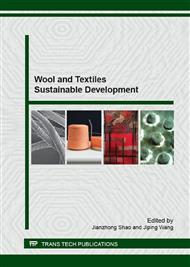[1]
C.W. Kan and C.W. M. Yuen. Effect of nature of gas on some surface physico-chemical properties of plasma-treated wool fiber, J. Journal of Adhesion Science and Technology, 24 (2010) 99–11.
DOI: 10.1163/016942409x12538865056079
Google Scholar
[2]
C. W. Kan, K. Chan, C. W. M. Yuen and M. H. Miao, Low temperature plasma on wool substrates: The effect of the nature of the gas, J. Textile Res. J, 69(1999) 407–416.
DOI: 10.1177/004051759906900604
Google Scholar
[3]
X. Zhao, J. X. He and Y. Z. Zhan. Research in the cold pad–batch dyeing process for wool pretreated by hydrogen peroxide, J. Coloration Technology, 125(2009)172-177.
DOI: 10.1111/j.1478-4408.2009.00192.x
Google Scholar
[4]
M. Marti, A De La Maza and J. L. Parra, et al. New generation of liposomic products with high migration properties, J. Textile Res. J, 74 (2004)961-966.
DOI: 10.1177/004051750407401104
Google Scholar
[5]
C. W. Chan, C. W. M. Yuen and M. H. Miao. Effect of low temperature plasma, chlorination, and polymer treatments and their combinations on the properties of wool fibers, J.S.D.C., 114 (1998)61-65.
DOI: 10.1177/004051759806801105
Google Scholar
[6]
J. Udakhe and S. Honade. Plasma induced physico-chemical changes & dyeing behavior of wool fabrics, J. Textile Chemical & Color Department, (2013)41-48.
Google Scholar
[7]
A. V. Ulesova, A .A. Grechko, S. F. Sadova. Continuous dyeing of wool fabric containing polyamide fibre and modified by plasma glow discharge, J. Fibre Chemistry, 2(2008)143-146.
DOI: 10.1007/s10692-008-9027-4
Google Scholar
[8]
S. M. Gawish, M. A. Saudy, S.M. Abo El-Ola, et al. The effect of low-temperature plasma for improving wool and chitosan-treated wool fabric properties, J. The Journal of the Textile Institute, 2(2011)180-188.
DOI: 10.1080/00405000.2010.483836
Google Scholar
[9]
S. Wang, X. H. Yang, Y. Y. Gong. Synthesis, spectral properties of cell-permeant dimethine cyanine dyes and their application as fluorescent probes in living cell imaging and flow cytometry, J. Textile Auxiliaries (in Chinese), 12 (2013) 24-27.
DOI: 10.1016/j.dyepig.2013.09.011
Google Scholar
[10]
Q. D. Wang, X. Ji, Y. Liu, et al. Study on dyeing properties of wool fabric treated with low temperature plasma ,J. Wool Textile Journal (in Chinese), 2(2006)9-12.
Google Scholar
[11]
R. Y. Zhu, J. K. Hua, G. Hang , et al. Research on dyeing properties of low temperature plasma treated wool fibers , J. Journal of Tianjin Polytechnic University (in Chinese), 4(2002)22-27.
Google Scholar
[12]
E. M. El-Khatib, W. M. Raslan, A. A. El-Halwagy, et al. Effect of low temperature plasma treatment on the properties of wool/polyester blend, J. Research Journal of Textile & Apparel, 1(2013): 124-132.
DOI: 10.1108/rjta-17-01-2013-b013
Google Scholar
[13]
Y. Guo, X. Li, Z. S. Cai. Dyeing behaviors of wool fabric with atmospheric plasma treatment, J. Dyeing & Finishing(in Chinese), 19(2005)1-4.
Google Scholar
[14]
X. Y. Wang,F. Ma,Z. Tong, et al. Proceedings of 2006 China International Wool Textile Conference & IWTO Wool Forum, Beijing: China Textile & Apparel Press, 5(2007)589-598.
Google Scholar
[15]
M. Mori, V. von Arnim, A. Dinkelmann, et al. Modification of wool fibers by atmospheric pressure plasma treatment, J. The Journal of The Textile Institute, 6(2011)534-539.
DOI: 10.1080/00405000.2010.498173
Google Scholar
[16]
J. Guo,J. P. He. Low temperature dyeing of wool with reactive dyes, J. Wool Textile Journal (in Chinese), 40(2012)32-26.
Google Scholar
[17]
C. S . Xu, Y . Ren, Q. Wu, J. W . Xing. Dyeing optim fiber with Lanasol CE dyestuff, J. Journal of Xi'an Polytechnic University (in Chinese), 26(2012)143-146.
Google Scholar
[18]
X.Y. Wang and Y. J. Liu. The dyeing dynamics and structure of modified cotton fabric with cationic chicken feather keratin agent, J. Textile Research Journal, (2013)1-11.
DOI: 10.1177/0040517513495947
Google Scholar
[19]
X.Y. Wang and Y. Peng. Comparative study of the structure and properties of wool treated by a chicken-feather keratin agent, plasma, and their combination, J. Journal of Applied Polymer Science, 119(2011)1627–1634.
DOI: 10.1002/app.32853
Google Scholar
[20]
Taylor & Francis Ltd. Journal of the Textile Institute (processing), 52(1961)678-680.
Google Scholar


